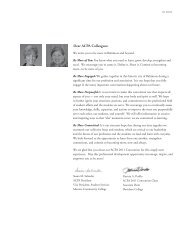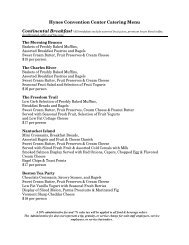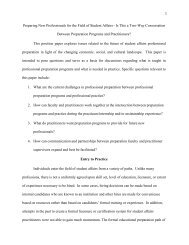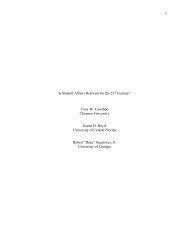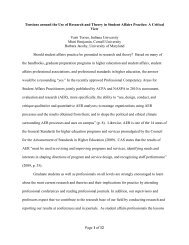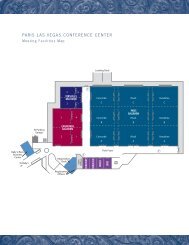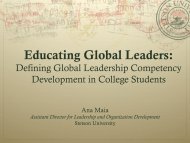The Role of Self within the Community of Student Affairs- How Can I ...
The Role of Self within the Community of Student Affairs- How Can I ...
The Role of Self within the Community of Student Affairs- How Can I ...
You also want an ePaper? Increase the reach of your titles
YUMPU automatically turns print PDFs into web optimized ePapers that Google loves.
<strong>The</strong> <strong>Role</strong> <strong>of</strong> <strong>Self</strong> <strong>within</strong> <strong>the</strong> <strong>Community</strong> <strong>of</strong> <strong>Student</strong> <strong>Affairs</strong>- <strong>How</strong> <strong>Can</strong> I be Au<strong>the</strong>ntic and Play<br />
Multiple <strong>Role</strong>s?<br />
Jan Arminio, Shippensburg University<br />
Susan R. Jones, <strong>The</strong> Ohio State University<br />
In this introduction, we (Jan and Susan) aim to explore <strong>the</strong> tensions between assumptions<br />
and values <strong>of</strong> <strong>the</strong> student affairs field related to leading au<strong>the</strong>ntic lives and <strong>the</strong> identity<br />
consequences that potentially result when fulfilling multiple roles in our work. We introduce<br />
multiple interpretations on this issue primarily by inviting responses from two colleagues in an<br />
effort to provoke conversations and questions while exposing possible places <strong>of</strong> common<br />
ground. We begin with our introduction, followed by responses from Ryan Holmes and Glen<br />
Sherman, both student affairs educators, and conclude with a few comments that summarize and<br />
integrate <strong>the</strong> <strong>the</strong>mes that emerge from this analysis related to <strong>the</strong> vexing nature <strong>of</strong> au<strong>the</strong>nticity in<br />
<strong>the</strong> context <strong>of</strong> institutional and pr<strong>of</strong>essional settings. <strong>The</strong> primary purpose <strong>of</strong> presenting <strong>the</strong>se<br />
multiple perspectives is to improve educational practices for students at our institutions by<br />
exposing identity issues experienced by student affairs educators and <strong>the</strong>ir potential impact on<br />
our ability to be successful and au<strong>the</strong>ntic in our work.<br />
<strong>Student</strong> development <strong>the</strong>ory and identity development more specifically, have served as<br />
<strong>the</strong> <strong>the</strong>oretical bedrock <strong>of</strong> student affairs practice for many years. From <strong>the</strong> <strong>Student</strong> Personnel<br />
Point <strong>of</strong> View (1937) forward, <strong>the</strong> education <strong>of</strong> <strong>the</strong> whole student has served as a central guiding<br />
philosophical principle for student affairs practice. Related, as Shields (2008) summarized, “In<br />
contemporary American society, identity is emphasized as a quality that enables <strong>the</strong> expression<br />
<strong>of</strong> <strong>the</strong> individual’s au<strong>the</strong>ntic sense <strong>of</strong> self” (p. 301). In student development scholarship, self-<br />
authorship (e.g., Baxter Magolda, 2001, 2009; Kegan, 1994) is advanced as a <strong>the</strong>ory that<br />
1
describes a holistic portrait <strong>of</strong> development. According to Kegan (1994), <strong>the</strong> demands <strong>of</strong> public<br />
life, including in <strong>the</strong> work place, requires a self-authorship that “can coordinate, integrate, act<br />
upon, or invent values, beliefs, convictions, generalizations, ideals, abstractions, interpersonal<br />
loyalties, and intrapersonal states (p. 185). <strong>How</strong>ever, although holistic in <strong>the</strong> integration <strong>of</strong><br />
cognitive, interpersonal, and identity domains <strong>of</strong> development, self-authorship does not<br />
necessarily integrate dimensions <strong>of</strong> race, social class, culture, or sexual orientation, for example<br />
(Jones, 2010). When <strong>the</strong>se dimensions are incorporated explicitly into <strong>the</strong> study <strong>of</strong> identity,<br />
au<strong>the</strong>nticity becomes more complicated (Jones, Kim, & Skendall, in press) and <strong>the</strong> work place<br />
serves as one significant context in which individuals wrestle with how to live au<strong>the</strong>ntic lives.<br />
For <strong>the</strong> most part, up until <strong>the</strong> recent past, it was expected that employees give up identity<br />
and culture at <strong>the</strong> employer’s door. As a result, employees took on <strong>the</strong> culture <strong>of</strong> <strong>the</strong> employer<br />
with little question. For some individuals this necessitated that employees “code switched” or<br />
“passed” as <strong>the</strong> prevailing norms and values <strong>of</strong> <strong>the</strong> institution or work place required that some<br />
individuals give up more <strong>of</strong> <strong>the</strong>mselves than o<strong>the</strong>rs (Willie, 2003). Code switching or code<br />
shifting refers to altering “from one linguistic code to ano<strong>the</strong>r depending on <strong>the</strong> communication<br />
setting or context” (Morrison, 2010, p. 95). <strong>How</strong>ever, people shifted not only how <strong>the</strong>y spoke,<br />
but also what <strong>the</strong>y wore, how <strong>the</strong>y acted, and even what music <strong>the</strong>y listened to at work. Passing<br />
“points to an act <strong>of</strong> deception as one is being accepted for something one is not” (Davidson,<br />
2010, p. 359). Willie (2003), in her study <strong>of</strong> college-educated African Americans from ei<strong>the</strong>r an<br />
HBCU or a PWI, distinguished between playing with racial expectations and stereotypes and<br />
passing. She wrote, “<strong>The</strong> ability to ‘play’ with racial stereotypes or assume <strong>the</strong>m for a specific<br />
purpose tells us about <strong>the</strong> malleability <strong>of</strong> race and racial stereotypes. Unlike ‘passing,’ this is<br />
2
less about pretending to be something one is not and more about pretending to be something one<br />
is thought to be” (p. 153).<br />
Generally, employees altered <strong>the</strong>ir behavior from home to work to comply with<br />
employers’ expectations and <strong>the</strong> cultural norms <strong>of</strong> <strong>the</strong> institution. <strong>How</strong>ever, with <strong>the</strong> recognition<br />
<strong>of</strong> <strong>the</strong> importance <strong>of</strong> cultural and social identity and <strong>the</strong> increased diversity <strong>of</strong> <strong>the</strong> work force,<br />
this dynamic created a tension among employees, some <strong>of</strong> whom became more reluctant to turn<br />
<strong>of</strong>f or turn away from <strong>the</strong>ir culture or social identity. For example, numerous accounts exist <strong>of</strong><br />
working class, poor, and first generation faculty and student affairs educators’ experiences in<br />
transitioning to a middle class environment. In writing about her interest in attending college,<br />
for Sowinska (1993) this meant:<br />
Leaving behind <strong>the</strong> familiar validations <strong>of</strong> experience and community <strong>of</strong>fered by my<br />
family and friends. My own passing included, among its manifestations, altering my<br />
speech, changing <strong>the</strong> way I dressed, remaining silent during conversations about my<br />
family, pretending to have enough money when I didn’t, claiming I wasn’t hungry when I<br />
was. I also developed a tendency toward automatic lying, filling in what I perceived as<br />
gaps in my background. (p. 152)<br />
To what degree is code switching and passing still expected or necessary? Moreover, how do<br />
<strong>the</strong>se coping strategies detract from an au<strong>the</strong>ntic self? About au<strong>the</strong>nticity Morgaine (1992)<br />
wrote, “Au<strong>the</strong>nticity is considered <strong>the</strong> natural by-product <strong>of</strong> self-formation processes founded on<br />
mutuality and respect” (p.11). Prellwitz (2010) described three dimensions <strong>of</strong> au<strong>the</strong>nticity, “<strong>the</strong><br />
quality <strong>of</strong> being or possessing reality, <strong>the</strong> quality <strong>of</strong> expressing truth” (p. 52), and <strong>the</strong> quality <strong>of</strong><br />
acting <strong>within</strong> one’s authority. Yet, Jones (2010) asked whe<strong>the</strong>r au<strong>the</strong>nticity is possible “given<br />
<strong>the</strong> shifting terrain <strong>of</strong> identity negotiations and <strong>the</strong> external constraints to au<strong>the</strong>nticity, which are<br />
3
influenced by context and <strong>the</strong> structures <strong>of</strong> power, privilege, and oppression” (p. 233). In a<br />
recent study using intersectionality as a framework, one participant captured this dynamic in<br />
relation to au<strong>the</strong>nticity and <strong>the</strong> necessary negotiating <strong>of</strong> identity when o<strong>the</strong>rs’ perceptions (such<br />
as in <strong>the</strong> workplace) are a significant factor:<br />
A mo<strong>the</strong>r, a wife, a woman, a daughter, a sister, an aunt, a niece, a pr<strong>of</strong>essional, a<br />
student, I am who you want me to be in different environments in different places at<br />
different times, but it does not stop here. I am Christian, I am Black, I am from <strong>the</strong> south,<br />
I am middle class, I am African American, which is <strong>the</strong> first identity seen by o<strong>the</strong>rs when<br />
I walk down <strong>the</strong> street, or enter a room. So to answer <strong>the</strong> question, who am I as a person,<br />
I am all <strong>of</strong> <strong>the</strong> above to different people in different settings at different times. (Jones,<br />
2009, p. 293)<br />
Beyond <strong>the</strong> questions raised above connecting issues <strong>of</strong> identity to behaviors at work, to<br />
what degree should it be expected that employees, including those in student affairs, “suck it up”<br />
and comply with institutional expectations particularly those outside <strong>the</strong>ir specific position<br />
description? <strong>How</strong> does <strong>the</strong> need to “suck it up” fit or not fit with our pr<strong>of</strong>ession’s values <strong>of</strong><br />
identity, integrity, teamwork, collaboration, and au<strong>the</strong>nticity? To what point does a student<br />
affairs pr<strong>of</strong>essional have <strong>the</strong> right to advocate for personal values or <strong>the</strong> values <strong>of</strong> o<strong>the</strong>rs? <strong>How</strong><br />
do institutional politics influence this? In what instances should student affairs pr<strong>of</strong>essionals<br />
“suck it up” and comply because a supervisor requires this? Contrarily, in what ways is <strong>the</strong> new<br />
generation <strong>of</strong> pr<strong>of</strong>essionals expecting to be accommodated?<br />
<strong>The</strong> Council for <strong>the</strong> Advancement <strong>of</strong> Standards in Higher education (CAS)<br />
Characteristics <strong>of</strong> Individual Excellence for Pr<strong>of</strong>essional Practice in Higher Education (2009)<br />
lists two potentially contradictory statements: pr<strong>of</strong>essionals “Abide by laws and institutional<br />
4
policies and work to change policies that are incongruent with personal and pr<strong>of</strong>essional<br />
principles” and pr<strong>of</strong>essionals “Re-evaluate continued employment when personal, pr<strong>of</strong>essional,<br />
and institution goals and values are incompatible and inhibit <strong>the</strong> pursuit <strong>of</strong> excellence” (p. 22).<br />
<strong>How</strong> does one know when it is time for <strong>the</strong> latter? Is <strong>the</strong> latter unreasonable considering <strong>the</strong><br />
economic realities <strong>of</strong> employment opportunities in higher education? What groups are more<br />
vulnerable in <strong>the</strong>se situations?<br />
This critical view essay <strong>the</strong>n in essence asks, what does it mean to be au<strong>the</strong>ntic in today’s<br />
work context? <strong>How</strong> does a director <strong>of</strong> <strong>the</strong> multicultural center represent both students and <strong>the</strong><br />
institution when students believe campus police are harassing students <strong>of</strong> color and <strong>the</strong><br />
administration does not? <strong>How</strong> should male employees respond to being asked to remove <strong>the</strong>ir<br />
earrings before alumni days? Should employees be forced to wear campus spirit shirts? <strong>How</strong><br />
should employees follow procedures as written when one <strong>of</strong> <strong>the</strong> players involved is inept?<br />
As Bronfenbrenner (1979) makes clear, people are influenced by several ecological<br />
spheres <strong>of</strong> influence. In student affairs those spheres include ourselves, our institutions, and our<br />
pr<strong>of</strong>ession. Few would deny that <strong>the</strong> socialization process for pr<strong>of</strong>essionals entering student<br />
affairs is imperative and involves <strong>the</strong> integration <strong>of</strong> <strong>the</strong> self acting <strong>within</strong> <strong>the</strong> culture <strong>of</strong> <strong>the</strong><br />
institution (Collins, 2009). Fur<strong>the</strong>rmore, as pr<strong>of</strong>essionals, we pr<strong>of</strong>ess our commitment to a<br />
vocation by using its principles as guides (Arminio, 2011). Additionally, critical to institutional<br />
culture are its leadership practices. To what degree is leadership hierarchical, transactional, or<br />
transformational and when and how should one adapt to <strong>the</strong>se cultural characteristics?<br />
Added to <strong>the</strong> complexity <strong>of</strong> this issue <strong>of</strong> au<strong>the</strong>nticity in <strong>the</strong> workplace is <strong>the</strong> current<br />
economic recession. <strong>The</strong> means that <strong>the</strong> ability to accomplish goals is <strong>of</strong>ten dependent upon<br />
5
esources and student affairs is embedded in an environment <strong>of</strong> declining public support. <strong>How</strong> is<br />
au<strong>the</strong>nticity impacted as educators grovel for adequate resources?<br />
<strong>How</strong>e and Strauss (2000) tried to debunk <strong>the</strong> idea that <strong>the</strong> millennial generation (those<br />
born from 1982-1998) is self-absorbed, instead <strong>the</strong>y described this generation as “cooperative<br />
team players” (p. 8). Contrarily, <strong>the</strong>se authors also noted <strong>the</strong> many social supports were initiated<br />
to protect this generation. Such supports include increased safety regulations many <strong>of</strong> which<br />
were prompted by <strong>the</strong> millennials’ boomer parents. <strong>How</strong> does being <strong>the</strong> target <strong>of</strong> consistent<br />
protections as a child influence <strong>the</strong> life as a working adult? Yet, do not all generations lament<br />
<strong>the</strong> perceived lack <strong>of</strong> talent <strong>of</strong> <strong>the</strong> next?<br />
In contemplating <strong>the</strong> above questions in <strong>the</strong> context <strong>of</strong> <strong>the</strong> relationship between <strong>the</strong> self<br />
and <strong>the</strong> community <strong>of</strong> student affairs, Susan and Jan welcome <strong>the</strong> reflections and experiences <strong>of</strong><br />
o<strong>the</strong>rs on balancing <strong>the</strong> needs <strong>of</strong> self and student affairs roles in relation to <strong>the</strong> question <strong>of</strong><br />
leading au<strong>the</strong>ntic lives and increased understanding about <strong>the</strong> tensions and identity negotiations<br />
involved. Below are two such reflections that add to <strong>the</strong> perspective <strong>of</strong> balancing self with<br />
pr<strong>of</strong>essional roles in <strong>the</strong> context <strong>of</strong> au<strong>the</strong>nticity. <strong>The</strong> first respondent, Ryan Holmes, uses his<br />
own experience and identity to frame his response. <strong>The</strong> second respondent, Glen Sherman,<br />
adapts a philosophical approach by drawing on <strong>the</strong> philosophy <strong>of</strong> Emmanuel Levinas to frame<br />
his response.<br />
<strong>The</strong> Will is <strong>the</strong> Limit: A Response to Arminio and Jones’ “<strong>The</strong> <strong>Role</strong> <strong>of</strong> <strong>Self</strong> <strong>within</strong> <strong>the</strong><br />
<strong>Community</strong> <strong>of</strong> <strong>Student</strong> <strong>Affairs</strong>”<br />
Ryan C. Holmes, University <strong>of</strong> Texas at El Paso<br />
6
In <strong>the</strong>ir comments above, Arminio and Jones make many thought provoking points with<br />
regard to <strong>the</strong> landscape <strong>of</strong> higher education. In <strong>the</strong>ir essay, <strong>the</strong> authors present that many<br />
pr<strong>of</strong>essionals on <strong>the</strong> college/university campus have <strong>the</strong> chance to be more “au<strong>the</strong>ntic” than <strong>the</strong>y<br />
ever have been. It is <strong>of</strong>fered that pr<strong>of</strong>essionals may not necessarily have to change <strong>the</strong>ir speech<br />
patterns, dress, and/or music choices as was <strong>the</strong> case a few decades ago. Fur<strong>the</strong>r, it is argued that<br />
employees may be less prone to limit <strong>the</strong>ir cultural and identity expressions at <strong>the</strong> request,<br />
spoken or unspoken, <strong>of</strong> <strong>the</strong>ir employers. Yet, conversely, <strong>the</strong> authors question whe<strong>the</strong>r<br />
employees should “suck it up” for <strong>the</strong> values <strong>of</strong> our pr<strong>of</strong>ession or for <strong>the</strong> employer? While <strong>the</strong><br />
upcoming response will not be all-encompassing in approaching such a vast set <strong>of</strong> issues, it is my<br />
hope that this perspective will be accepted as being from a student affairs pr<strong>of</strong>essional who truly<br />
loves <strong>the</strong> pr<strong>of</strong>ession while not consciously trying to fit in at <strong>the</strong> expense <strong>of</strong> self.<br />
To better understand my position, one must consider my perspective; that <strong>of</strong> a large (6’1,<br />
300+ lb), heterosexual, African American male, who has been afforded opportunities while<br />
having to overcome adverse circumstances, and still does not accept <strong>the</strong> belief that <strong>the</strong> United<br />
States is in a “Post” anything (i.e. post-race, post-gender, post-sexual orientation, post-<br />
socioeconomic status) time in our country’s history. Yes, it can be seen that <strong>the</strong> ability to be<br />
more au<strong>the</strong>ntic has improved relatively speaking. Relative to a previous time where affirmative<br />
action policies had to be instituted for persons outside <strong>of</strong> an accepted class to gain entry to <strong>the</strong><br />
workplace and admission to certain institutions <strong>of</strong> education. Relative to political climates that<br />
prompted a civil rights movement in <strong>the</strong> 1950s, women’s rights movements in <strong>the</strong> late 19th and<br />
early 20th centuries, and <strong>the</strong> Stonewall Riots <strong>of</strong> 1969, <strong>the</strong> event largely regarded as a catalyst for<br />
<strong>the</strong> LGBT movement for civil rights. <strong>How</strong>ever, au<strong>the</strong>nticity in <strong>the</strong> ideal sense that many believe<br />
surfaced in <strong>the</strong> aftermath <strong>of</strong> <strong>the</strong> 2008 Presidential Election is not truly pervasive. Fur<strong>the</strong>r, <strong>the</strong><br />
7
impacts <strong>of</strong> true au<strong>the</strong>nticity that include institutions <strong>of</strong> higher education and <strong>the</strong> student affairs<br />
pr<strong>of</strong>ession will probably not be seen for some time to come.<br />
In <strong>the</strong> pr<strong>of</strong>essional realm <strong>of</strong> <strong>of</strong>fice environments and higher education, it is still (in many<br />
cases) expected that employees “adjust <strong>the</strong>ir identity and culture at <strong>the</strong> employer’s door.”<br />
Sowinska (1993) provides <strong>the</strong> example where “familiar validations <strong>of</strong> experience and<br />
community” are left behind, where <strong>the</strong> act <strong>of</strong> self-denial is a key to not drawing unwanted<br />
attention, and where it is assumed that maximizing one’s potential is contingent upon how well<br />
you get along with colleagues so that what you know can be appreciated. This still happens<br />
today. It happens when someone <strong>of</strong> multiple oppressions changes <strong>the</strong> way he/she speaks since<br />
his/her degrees or pertinent life experiences cannot be seen in <strong>the</strong> conversation. It happens when<br />
<strong>the</strong> underrepresented person takes several loans to finance higher education and degree<br />
attainment so that <strong>the</strong> remaining earned income (after payment <strong>of</strong> loans) may not be enough to<br />
join colleagues in building a social network. It happens when a person feels <strong>the</strong> need to dress up<br />
a bit more because dressing comfortably may be viewed as unpr<strong>of</strong>essional unless <strong>the</strong> person is<br />
well known or has a “pr<strong>of</strong>essional” look to <strong>of</strong>fset negative perceptions. It happens when one has<br />
very few colleagues <strong>of</strong> one’s own cultural background based on hiring practices or lack <strong>of</strong><br />
opportunities; unless one “passes” for possessing <strong>the</strong> ideals <strong>of</strong> <strong>the</strong> mainstream. It happens when<br />
a person has a “work” music playlist that would never feature certain music selections for fear <strong>of</strong><br />
being typecast. <strong>How</strong>ever, many <strong>of</strong> <strong>the</strong>se situations, although noticed, are noticed silently. Such<br />
acts <strong>of</strong> self-denial are pro<strong>of</strong> that bigotry exists in <strong>the</strong> institutions that tell students to be au<strong>the</strong>ntic<br />
as <strong>the</strong>y strive to maximize <strong>the</strong>ir potential; as we tell students and o<strong>the</strong>r pr<strong>of</strong>essionals that we<br />
value diversity.<br />
8
<strong>The</strong>se aforementioned instances display that being au<strong>the</strong>ntic is a continuous struggle and<br />
that “wearing <strong>the</strong> mask” and “code switching” are still prevalent. Yet, <strong>the</strong>re is no better place to<br />
witness a break from “masks” than at a conference, specifically a national one. Such a setting<br />
allows pr<strong>of</strong>essionals to use <strong>the</strong> time between sessions and after hours to spend time with<br />
colleagues across <strong>the</strong> country who accept <strong>the</strong>m for who <strong>the</strong>y really are. It also allows<br />
pr<strong>of</strong>essionals to dress how <strong>the</strong>y feel ra<strong>the</strong>r than how <strong>the</strong>y are expected to, and provides a forum<br />
for subgroups <strong>of</strong> people to converse in <strong>the</strong> style that displays <strong>the</strong>ir upbringing and not how <strong>the</strong>y<br />
have been trained to speak. None<strong>the</strong>less, <strong>the</strong>se freeing experiences must be enjoyed before one<br />
returns to <strong>the</strong> <strong>of</strong>fice where he/she is paid to assume <strong>the</strong> “whole” role <strong>of</strong> being a pr<strong>of</strong>essional. It is<br />
<strong>the</strong>n that code switching must be employed until <strong>the</strong> person has been <strong>the</strong>re long enough to be<br />
seen as “non-threatening” or simply “ok.” Even <strong>the</strong>n, <strong>the</strong> context in which <strong>the</strong> person lives and<br />
works determines how long acceptance will take and /or decides if <strong>the</strong> person can ever work<br />
toward au<strong>the</strong>nticity. In fact, <strong>the</strong>re are many facets that can determine a person’s space to be<br />
au<strong>the</strong>ntic. <strong>The</strong> dividing line between what is acceptable or not can be determined by <strong>the</strong><br />
demographic <strong>of</strong> <strong>the</strong> location (urban, rural, affluent, underprivileged), institutional type (ivy-<br />
league, community college, liberal arts, technical) or in some cases, <strong>the</strong> department (i.e. Vice<br />
President’s Office, <strong>Student</strong> Activities, <strong>Student</strong> Conduct) just to name a few. Ano<strong>the</strong>r aspect that<br />
can possibly determine a person’s level <strong>of</strong> au<strong>the</strong>nticity is position title. I am quite sure that a<br />
coordinator in a traditional student activities <strong>of</strong>fice would be granted more <strong>of</strong> an exception to be<br />
au<strong>the</strong>ntic than a director, Dean or a Vice President. <strong>How</strong>ever, <strong>the</strong> coordinator’s promotion may<br />
be in jeopardy, regardless <strong>of</strong> how well <strong>the</strong>y are versed in <strong>the</strong> pr<strong>of</strong>ession, if it is determined that<br />
<strong>the</strong> person is not in line with institutional culture because <strong>the</strong>y have chosen not to suppress who<br />
he/she really is. Why? Because even though one is given more access and autonomy at <strong>the</strong><br />
9
upper levels to make decisions on behalf <strong>of</strong> <strong>the</strong> institution, <strong>the</strong>re is less autonomy to be an<br />
individual while simultaneously being an ambassador.<br />
One <strong>of</strong> most crucial questions presented in Arminio and Jones’ essay can be reduced to<br />
<strong>the</strong> following three words: is au<strong>the</strong>nticity possible? To answer Jones (2010), I do believe that<br />
au<strong>the</strong>nticity is possible. <strong>How</strong>ever, by not achieving au<strong>the</strong>nticity in a way that is permissible by<br />
cultural power centers, one may very well be volunteering to limit his/her upward progress. One<br />
could be seen as not playing by <strong>the</strong> “established” rules and, by not doing so, could be less<br />
understood and subsequently less trusted. “If I place this person on a search committee, would<br />
this person represent <strong>the</strong> university well?” “What would <strong>the</strong> members <strong>of</strong> a divisional committee<br />
think <strong>of</strong> this person’s opinion if her/his hairstyle serves as a distraction?” Also, it must be<br />
understood that though au<strong>the</strong>nticity can be seen as an individual battle, many (who subscribe to<br />
social groups) may still view au<strong>the</strong>nticity as a social group struggle and will guide <strong>the</strong>ir actions<br />
based on <strong>the</strong> perceived readiness <strong>of</strong> <strong>the</strong> locale to accept <strong>the</strong>ir attempts at au<strong>the</strong>nticity. For<br />
example, social groups as well as individuals can be <strong>the</strong> targets <strong>of</strong> oppression (Holmes, Edwards,<br />
DeBowes, 2009). <strong>The</strong> word oppression is used purposefully, because societal structures support,<br />
encourage, and reinforce prejudices that have been put in place by those who have been afforded<br />
unearned advantages (Holmes, Edwards, DeBowes, 2009). In this case, unearned advantages<br />
can also manifest <strong>the</strong>mselves in not having to be concerned with adapting to a mainstream <strong>of</strong>fice<br />
environment.<br />
<strong>The</strong>re is yet ano<strong>the</strong>r way to interpret <strong>the</strong> actions <strong>of</strong> those who choose to be “inau<strong>the</strong>ntic.”<br />
<strong>The</strong>re may be many who “play a role,” “wear <strong>the</strong> mask,” and “code switch” not because <strong>the</strong>y are<br />
inau<strong>the</strong>ntic but because <strong>the</strong>y would ra<strong>the</strong>r use <strong>the</strong>ir energies in o<strong>the</strong>r areas than <strong>the</strong> energy-<br />
draining arena <strong>of</strong> fighting to change perceptions on a road to false equity; a road that manifests<br />
10
itself in scholarly discourse but not in deeds, advocacy, and opportunities. <strong>The</strong>re are many who<br />
would ra<strong>the</strong>r blend in so that <strong>the</strong>y can remain valuable resources for <strong>the</strong> students that remind<br />
<strong>the</strong>m <strong>of</strong> <strong>the</strong>ir earlier years; so that <strong>the</strong>y can hold true to <strong>the</strong> student affairs mantra <strong>of</strong> being<br />
student-centered even if it comes at <strong>the</strong> expense <strong>of</strong> being true to <strong>the</strong>mselves.<br />
It is important to note that I am not suggesting that <strong>the</strong> world <strong>of</strong> student affairs, or <strong>the</strong><br />
work environment, should be a free-for-all with no regularity. <strong>The</strong>re are some aspects that<br />
should be uniform in <strong>the</strong> higher education environment: life-long learning, scholarship (which<br />
can differ from life-long learning), and <strong>the</strong> desire to work with and for students. If cultural<br />
and/or identity manifestations interrupt <strong>the</strong> flow <strong>of</strong> <strong>the</strong> aforementioned <strong>the</strong>n, yes, <strong>the</strong>y do need to<br />
be checked. <strong>How</strong>ever, I find it hard to understand how an individual being personally au<strong>the</strong>ntic<br />
can cause interference. It seems to be <strong>the</strong> goal <strong>of</strong> many student affairs pr<strong>of</strong>essionals to<br />
encourage students to be <strong>the</strong>mselves, to find <strong>the</strong>ir aims, and to establish/achieve <strong>the</strong>ir goals. Yet,<br />
I have personally seen that if one allows <strong>the</strong>ir personal values to shield <strong>the</strong>m from accepting <strong>the</strong><br />
newest student affairs trends, he/she can be seen as too conservative to meet students where <strong>the</strong>y<br />
are. Yet, what if we are teaching students how to lie to <strong>the</strong> world by being personally inau<strong>the</strong>ntic<br />
as we teach <strong>the</strong>m to strive toward au<strong>the</strong>nticity?<br />
And yet, <strong>the</strong>re still remains <strong>the</strong> realm <strong>of</strong> institutional politics. Institutional politics only<br />
influence genuineness to <strong>the</strong> point that individuals allow <strong>the</strong>mselves to be controlled. This<br />
includes <strong>the</strong> person’s desire to be “liked,” <strong>the</strong> likelihood <strong>of</strong> ga<strong>the</strong>ring resources for programs, and<br />
wondering if <strong>the</strong> work setting will change to <strong>the</strong> point that it impacts <strong>the</strong> person’s desire to<br />
remain in <strong>the</strong> environment. Any person has <strong>the</strong> right to advocate for whatever cause <strong>the</strong>y choose<br />
so long as it does not target protective classes or constitute hate speech; it is a constitutional<br />
right. Yet, <strong>the</strong> person must also understand that <strong>the</strong> institution has <strong>the</strong> right to select who<br />
11
epresents it. Hence, it is my belief that one can tell a lot about an institution by merely<br />
observing its workforce. Not necessarily <strong>the</strong> surface diversity (though that is still important even<br />
today), but by observing <strong>the</strong> messages that come forth from its decisions, stances, and traditions.<br />
<strong>The</strong>n all can see how au<strong>the</strong>ntic is “too” au<strong>the</strong>ntic and who is afforded <strong>the</strong> privilege <strong>of</strong> exhibiting<br />
such au<strong>the</strong>nticity.<br />
In closing, one must merely look to <strong>the</strong> past for lessons about au<strong>the</strong>nticity. We remember<br />
those whom we consider to be <strong>the</strong> greatest <strong>of</strong> <strong>the</strong>ir time for one reason; <strong>the</strong>y were genuine. <strong>The</strong>y<br />
did not ask for permission to live, but <strong>the</strong>y lived boldly while presenting a different side <strong>of</strong><br />
humanity. This was <strong>the</strong> same for Muhammad Ali, Mo<strong>the</strong>r <strong>The</strong>resa, Cesar Chavez, and Harvey<br />
Milk just to name a few. <strong>The</strong>se people challenged <strong>the</strong> system to accept <strong>the</strong>m as <strong>the</strong>y were; to<br />
honor <strong>the</strong>m as members <strong>of</strong> <strong>the</strong> social groups that <strong>the</strong>y claimed and represented. <strong>The</strong>y also<br />
displayed true courage in societal climates that were arguably much more hostile than <strong>the</strong>y are<br />
currently. Finally, if student affairs pr<strong>of</strong>essionals hope to inspire and create whole students, it is<br />
equally important that <strong>the</strong> pr<strong>of</strong>ession seeks to inspire genuine pr<strong>of</strong>essionals.<br />
Compelling Each Toward <strong>the</strong> O<strong>the</strong>r: <strong>The</strong> Ethics <strong>of</strong> Emmanuel Levinas<br />
Glen L. Sherman, William Paterson University<br />
<strong>The</strong> challenges young student affairs pr<strong>of</strong>essionals face are many and varied. Barely<br />
having mastered or, more likely, still learning various <strong>the</strong>oretical approaches to practice, <strong>the</strong>y are<br />
thrust into institutions with traditions and expectations <strong>the</strong>y may not be fully familiar with and<br />
which may or may not coincide with <strong>the</strong>ir personal values and beliefs. <strong>The</strong>y are also probably<br />
still integrating <strong>the</strong> pr<strong>of</strong>essional standards and ethical principles <strong>the</strong>y learned about in graduate<br />
school, while also figuring out <strong>the</strong>ir own pr<strong>of</strong>essional value systems and simultaneously putting<br />
12
<strong>the</strong>m into practice. ACPA’s own Ethical Principles and Standards encourage members to<br />
“adopt a personal value system congruent with <strong>the</strong> basic tenets <strong>of</strong> <strong>the</strong> pr<strong>of</strong>ession” (ACPA, 2006,<br />
p. 3).<br />
All <strong>of</strong> this is quite complicated and probably happening for <strong>the</strong> young pr<strong>of</strong>essional<br />
outside <strong>the</strong> realm <strong>of</strong> explicit consciousness, unless or until something happens that presents an<br />
ethical dilemma. Such a dilemma, like <strong>the</strong> possible clash <strong>of</strong> personal and pr<strong>of</strong>essional values<br />
described in Jan and Susan’s Introduction (e.g., a male employee who is asked by a supervisor to<br />
remove an earring prior to an Open House, or an employee concerned about bringing to a<br />
supervisor student complaints <strong>of</strong> unfair treatment by Campus Police toward certain students<br />
based on race or ethnicity), presents young pr<strong>of</strong>essionals with a conflict, perhaps even a crisis, as<br />
<strong>the</strong>y encounter <strong>the</strong> issue <strong>of</strong> what <strong>the</strong> traditions and beliefs <strong>of</strong> <strong>the</strong> institution really are, and<br />
attempt to sort out what <strong>the</strong>y think and believe, how <strong>the</strong>y feel, and what <strong>the</strong>y wish to do.<br />
Jan and Susan pose <strong>the</strong> issue as one <strong>of</strong> both au<strong>the</strong>nticity, <strong>the</strong> young pr<strong>of</strong>essional<br />
remaining true to his or her own personal, ethnic, familial, socio-cultural, or economic values<br />
and “self,” and how <strong>the</strong> individual navigates between owned individual values and a supervisor’s<br />
or <strong>the</strong> institution’s values and requirements <strong>of</strong> employees, referred to as institutional culture.<br />
<strong>The</strong> latter issue, according to critical <strong>the</strong>ory, tends to lead to discussions <strong>of</strong> power, privilege, and<br />
oppression. Critical <strong>the</strong>ory, briefly stated, explores human freedom as it may be circumscribed<br />
or constrained by social, political, or economic conditions (Hayes & Singh, 2012). I believe that<br />
this perspective is prevalent in higher education. This is understandable given <strong>the</strong> diversity and<br />
economic disparity present in our institutions. <strong>How</strong>ever, I would like to pose ano<strong>the</strong>r perspective<br />
on this situation, one which seems equally relevant. <strong>The</strong> perspective emanates from <strong>the</strong> ethical<br />
writings <strong>of</strong> Emmanuel Levinas, a twentieth century French Continental philosopher perhaps little<br />
13
known to <strong>the</strong> field <strong>of</strong> student affairs. Levinas proposes an original understanding <strong>of</strong> ethics which<br />
<strong>of</strong>fers a unique perspective on <strong>the</strong> dilemma Jan and Susan have posed. I will introduce Levinas<br />
by way <strong>of</strong> a few brief biographical facts and <strong>the</strong>n sketch his philosophy <strong>of</strong> ethics. Finally, I will<br />
apply <strong>the</strong> questions raised by his philosophical ideas to <strong>the</strong> examples cited.<br />
Levinas was born and raised in Eastern Europe in <strong>the</strong> early nineteen hundreds. He was<br />
raised in an orthodox Jewish family, where <strong>the</strong> study <strong>of</strong> Talmud, Jewish law, was strictly adhered<br />
to. He grew up also reading <strong>the</strong> premier “existential” Russian authors <strong>of</strong> <strong>the</strong> time (e.g.,<br />
Dostoyevsky and Tolstoy). He moved to France as a young man, where he enrolled in university<br />
and focused his studies on philosophy. Levinas <strong>the</strong>n went to Freiburg, Germany, where he<br />
studied philosophy with Edmund Husserl and Martin Heidegger. Subsequently, Levinas was a<br />
soldier in <strong>the</strong> French army. He was captured and although Jewish, spent time as a prisoner <strong>of</strong><br />
war ra<strong>the</strong>r than in a concentration camp. He survived but <strong>the</strong> majority <strong>of</strong> his family was killed in<br />
concentration camps. This is an important fact to recall as we consider Levinas’ reflections on<br />
human ethics. (For a deeper understanding <strong>of</strong> au<strong>the</strong>nticity and how it applies to work in student<br />
affairs, see Sherman, 2009.)<br />
In many respects, much <strong>of</strong> Levinas’ writing is a response to o<strong>the</strong>r philosophers’<br />
contentions that consciousness defines our relationship to <strong>the</strong> world and o<strong>the</strong>rs and that<br />
au<strong>the</strong>nticity may be defined as an individual being true to her “own most” self. Levinas thinks<br />
that <strong>the</strong>se basic definitions, or essential philosophical assumptions, are misguided readings <strong>of</strong> <strong>the</strong><br />
phenomena, <strong>the</strong> text and texture <strong>of</strong> experience. This is so because for Levinas it is a<br />
misconception to think <strong>of</strong> <strong>the</strong> self as an autonomous entity which is <strong>the</strong> starting point <strong>of</strong><br />
experience and ethical thinking. Ra<strong>the</strong>r, for Levinas, ethics and <strong>the</strong> ethical relation begin with<br />
<strong>the</strong> way that <strong>the</strong> subject is first and foremost compelled by <strong>the</strong> “face <strong>of</strong> <strong>the</strong> o<strong>the</strong>r.” O<strong>the</strong>rness<br />
14
constitutes <strong>the</strong> subject before <strong>the</strong> subject is even aware <strong>of</strong> it (i.e., before even <strong>the</strong> time <strong>of</strong><br />
intentional consciousness) is perhaps <strong>the</strong> most difficult idea at <strong>the</strong> heart <strong>of</strong> Levinas’ philosophy.<br />
In positing this notion <strong>of</strong> <strong>the</strong> subject, Levinas challenges notions <strong>of</strong> temporality as revolving<br />
around a present which binds <strong>the</strong> past and future through a present identity (what he calls <strong>the</strong><br />
“Same”), one <strong>of</strong> <strong>the</strong> main concepts around which student affairs <strong>the</strong>ory is built. To go one step<br />
fur<strong>the</strong>r, as much as student affairs work and <strong>the</strong>ory is also grounded in respect for <strong>the</strong> o<strong>the</strong>r,<br />
fairness and justice, Levinas’ suggestions about how <strong>the</strong> o<strong>the</strong>r factors into our very being and<br />
reckoning as a self, and how this bears upon interpersonal relations, is very different than <strong>the</strong><br />
usual conceptions <strong>of</strong> <strong>the</strong> self and interpersonal relations in student affairs. Typically <strong>the</strong> self is<br />
conceived as an autonomous, self-identical psychological entity. Depending upon <strong>the</strong> school <strong>of</strong><br />
psychology one adheres to, <strong>the</strong> psychological self might be seen as primarily comprised <strong>of</strong><br />
thoughts (cognitions) or feelings (affects), or as has been <strong>the</strong> case in seminal student affairs<br />
documents, as a combination <strong>of</strong> feelings and thoughts in a “whole” person. Interpersonal<br />
relations (such as those discussed by Baxter Magolda, 2001) are <strong>the</strong>n conceived <strong>of</strong> as two<br />
separate identities or selves interacting with one ano<strong>the</strong>r. This difference has far-reaching<br />
implications for a student affairs ethic.<br />
To frame ethics from this radical starting point is to contradict a long line <strong>of</strong> ethical<br />
thinking (going back, for instance, to Immanuel Kant’s categorical imperative) but it also goes<br />
against our typical thinking in student affairs, which extols <strong>the</strong> self, whe<strong>the</strong>r in terms <strong>of</strong> our<br />
reverence for psychologically based developmental <strong>the</strong>ory, or our inclination to assert and<br />
defend individual human rights above all else. What is unique and compelling about Levinas’<br />
ethical philosophy is his contention that giving individual consciousness priority in defining who<br />
we are is misguided. Such claims, he argues, come too late. <strong>The</strong>y are based on an ontology, a<br />
15
easoning about being, which misses a more primordial dimension <strong>of</strong> experience which occurs<br />
before <strong>the</strong> separation <strong>of</strong> self and o<strong>the</strong>r. In fact, Levinas describes this more essential dimension<br />
<strong>of</strong> human being as “<strong>the</strong> one for <strong>the</strong> o<strong>the</strong>r.” What this phrase suggests is an essential<br />
responsibility to <strong>the</strong> o<strong>the</strong>r which comes first, and comprises who we are just as much as our<br />
individual level <strong>of</strong> need and want which we become aware <strong>of</strong> in consciousness. This premise<br />
pre-scribes an indelible responsibility to <strong>the</strong> o<strong>the</strong>r which marks our being-in-<strong>the</strong>-world. <strong>The</strong><br />
“o<strong>the</strong>r” is in a fundamental sense constitutive <strong>of</strong> <strong>the</strong> self, and presents <strong>the</strong> self with an irresistible,<br />
undeniable responsibility before even <strong>the</strong> ontic (everyday, conscious) level <strong>of</strong> <strong>the</strong>ir demand. To<br />
say “o<strong>the</strong>r” <strong>the</strong>n is to imply two things; first, in ordinary terms, ano<strong>the</strong>r person, ano<strong>the</strong>r subject<br />
who stands before <strong>the</strong> self in an encounter and second, <strong>the</strong> way, for Levinas, <strong>the</strong> o<strong>the</strong>r’s presence<br />
actually constitutes <strong>the</strong> self in an essential manner.<br />
Levinas’ philosophy is a critique <strong>of</strong> <strong>the</strong> metaphysics <strong>of</strong> being, <strong>of</strong> presence, from which<br />
notions <strong>of</strong> individuality, commitment, ethics and morality, as acts <strong>of</strong> will, stem. Ra<strong>the</strong>r, for<br />
Levinas, <strong>the</strong> self’s more basic responsibility to <strong>the</strong> o<strong>the</strong>r stems first and foremost from <strong>the</strong> fact<br />
that <strong>the</strong> o<strong>the</strong>r’s presence is fundamentally constitutive <strong>of</strong> subjectivity, and which may more<br />
accurately be defined as “<strong>the</strong>-one-in-<strong>the</strong>-place-<strong>of</strong>-<strong>the</strong>-o<strong>the</strong>r” or “substitution.” <strong>The</strong> self’s<br />
fundamental responsibility and obligation to <strong>the</strong> o<strong>the</strong>r exists because that is who <strong>the</strong> “I” is, before<br />
presence, before <strong>the</strong> present time in which <strong>the</strong> self becomes aware <strong>of</strong> itself as a subject. In fact,<br />
following this line <strong>of</strong> thinking through, Levinas describes how <strong>the</strong> o<strong>the</strong>r actually emanates from<br />
<strong>the</strong> self, seizing it before any reflective awareness. It is out <strong>of</strong> this past that <strong>the</strong> self’s obligation,<br />
commitment, and <strong>the</strong> necessity to address <strong>the</strong> o<strong>the</strong>r arises.<br />
To be clear, it is not that Levinas was oblivious to <strong>the</strong> everyday phenomenal experience<br />
<strong>of</strong> <strong>the</strong> self as individual, as <strong>the</strong> “oneself” as he puts it. Having lived through <strong>the</strong> holocaust (and<br />
16
having experienced great personal loss), he also was certainly not blind to man’s potential<br />
inhumanity to man. <strong>How</strong>ever, his analysis attempts to penetrate more deeply <strong>within</strong>, or<br />
antecedent to <strong>the</strong> oneself, and in a very original way, this led him to <strong>the</strong> “o<strong>the</strong>r.” For Levinas,<br />
subjectivity, before it is “for itself,” an object <strong>of</strong> reflection which returns to itself, is first and<br />
foremost “for <strong>the</strong> o<strong>the</strong>r,” in <strong>the</strong> “face <strong>of</strong> <strong>the</strong> o<strong>the</strong>r.” This is not to say that individuals cannot turn<br />
away from this and deny ano<strong>the</strong>r’s humanity. But Levinas saw this possibility as secondary to<br />
<strong>the</strong> ethical obligation that is primary.<br />
What does this have to do with our young student affairs pr<strong>of</strong>essional? First and<br />
foremost, Levinas’ position suggests that we frame <strong>the</strong> ethical dilemma <strong>of</strong> <strong>the</strong> young pr<strong>of</strong>essional<br />
remaining true to his or her own personal “self” as primarily between individuals infused by <strong>the</strong><br />
unique dynamic described above, that I first am myself because <strong>of</strong> o<strong>the</strong>rs, who I am is self-in-<br />
relation, and I must consider who I am with you. An institution (any institution) may always be<br />
conceived as comprised <strong>of</strong> individuals. Even if an institution creates mission and values<br />
statements, goals and objectives, <strong>the</strong>se documents are always interpreted, represented, and<br />
enacted by individuals in relation to one ano<strong>the</strong>r – in this case <strong>the</strong> supervisor with <strong>the</strong> young<br />
pr<strong>of</strong>essional, or perhaps <strong>the</strong> young pr<strong>of</strong>essional in relation to students. But for Levinas, an<br />
individual is always an individual in relation to ano<strong>the</strong>r, not separate and distinct. In any<br />
interpersonal situation, <strong>the</strong>re is always already an ethical demand which precedes <strong>the</strong> surface-<br />
level relationship, a prior claim <strong>of</strong> accountability to <strong>the</strong> o<strong>the</strong>r, a way <strong>the</strong> o<strong>the</strong>r’s needs are already<br />
embedded in <strong>the</strong> imperative to respond. Certainly, <strong>the</strong> subject can turn away, turn a deaf ear to<br />
<strong>the</strong> needs <strong>of</strong> <strong>the</strong> o<strong>the</strong>r – that is, refuse to consider whe<strong>the</strong>r <strong>the</strong>re is any merit to <strong>the</strong> o<strong>the</strong>r’s<br />
request, whe<strong>the</strong>r policy needs to be changed, – and take a stand on abstract written policy, but<br />
this is already a denial <strong>of</strong> <strong>the</strong> o<strong>the</strong>r’s demand, and a negation <strong>of</strong> one’s incarnate obligation.<br />
17
This obligation cuts two ways. <strong>The</strong> supervisor must hear <strong>the</strong> young pr<strong>of</strong>essional’s needs and<br />
concerns, must reckon with <strong>the</strong>m, even as <strong>the</strong>y reckon with <strong>the</strong> principles <strong>of</strong> <strong>the</strong>ir supervisor and<br />
<strong>the</strong> policies <strong>the</strong>y are attempting to uphold. It is always a question <strong>of</strong> someone for ano<strong>the</strong>r, a<br />
series <strong>of</strong> relations between real people already engaged with <strong>the</strong> o<strong>the</strong>r’s needs. It is not simply a<br />
question <strong>of</strong> <strong>the</strong> supervisor rationally defending institutional principles to <strong>the</strong> young pr<strong>of</strong>essional<br />
and <strong>the</strong> pr<strong>of</strong>essional being left to sort out <strong>the</strong>ir decision in isolation. To frame <strong>the</strong> problem in<br />
this vacuous way is to miss <strong>the</strong> obligation each has to <strong>the</strong> o<strong>the</strong>r, <strong>the</strong> investment already running<br />
through, saturating <strong>the</strong> encounter. It is emotional; it is a matter <strong>of</strong> livelihood. It is not primarily<br />
a question <strong>of</strong> sorting out whose values make more sense, or who holds <strong>the</strong> power to enforce<br />
certain values. Levinas would argue that <strong>the</strong> ethical relation speaks first and compels each<br />
toward <strong>the</strong> o<strong>the</strong>r in an intimacy which compels a different type <strong>of</strong> “saying,” more original and<br />
au<strong>the</strong>ntic than an arguing over whose values are right or make more sense. Such saying elevates<br />
<strong>the</strong> dialogue beyond right and wrong or a demand that <strong>the</strong> o<strong>the</strong>r comply with one’s wish or<br />
value. It is not simply a question <strong>of</strong> who has greater power.<br />
Very concretely, through dialog with <strong>the</strong> supervisor, <strong>the</strong> young pr<strong>of</strong>essional might have a<br />
change <strong>of</strong> heart and remove <strong>the</strong> earring because he comes to see that <strong>the</strong> open house is about <strong>the</strong><br />
success <strong>of</strong> <strong>the</strong> institution not <strong>the</strong> individual’s identity, not simply because <strong>the</strong> supervisor says so.<br />
Similarly, <strong>the</strong> young pr<strong>of</strong>essional’s supervisor, after considering <strong>the</strong> possibility that students are<br />
being treated unfairly, may take <strong>the</strong> young pr<strong>of</strong>essional’s “case” to <strong>the</strong>ir superior. <strong>The</strong>re <strong>the</strong>y<br />
would engage in a similar person-to-person dialogue which <strong>the</strong> young pr<strong>of</strong>essional just engaged<br />
<strong>the</strong> supervisor in about <strong>the</strong> significance <strong>of</strong> <strong>the</strong> institution’s values statement proscribing <strong>the</strong><br />
behavior in question and what <strong>the</strong> institution is really doing about living up to its word. <strong>The</strong>se<br />
examples transcend personal values and au<strong>the</strong>nticity; <strong>the</strong>y are a function <strong>of</strong> what emanates from<br />
18
<strong>the</strong> prior obligation and demand <strong>of</strong> <strong>the</strong> interpersonal encounter, <strong>the</strong> claim <strong>the</strong> o<strong>the</strong>r makes. It is<br />
only a question <strong>of</strong> <strong>the</strong> self remaining open to and heeding this demand, ra<strong>the</strong>r than closing it <strong>of</strong>f<br />
and ignoring it. While we might initially be inclined to sympathize and side with <strong>the</strong> less<br />
powerful, young pr<strong>of</strong>essional’s right to <strong>the</strong>ir personal values about how <strong>the</strong>y dress, for example,<br />
or automatically assume <strong>the</strong> institution, as represented in <strong>the</strong> supervisor, will remain deaf to <strong>the</strong><br />
possibility <strong>of</strong> institutional racism, Levinas, I think, would argue that more is possible. Similarly,<br />
I think Levinas would say that simply defending <strong>the</strong> values <strong>of</strong> <strong>the</strong> institution and <strong>the</strong> young<br />
pr<strong>of</strong>essional’s choice to leave it if <strong>the</strong> values are not a good fit, is insufficient. Both positions<br />
overlook <strong>the</strong> possibility that before ei<strong>the</strong>r posed <strong>the</strong>ir position, <strong>the</strong>y are two subjects whose<br />
individual claims are preceded by <strong>the</strong> claims <strong>of</strong> <strong>the</strong> o<strong>the</strong>r.<br />
Summary<br />
<strong>The</strong> discourse here reminds us that <strong>the</strong> supervisor who comes to ask <strong>the</strong> employee to<br />
remove his earring already has a relationship with <strong>the</strong> employee. <strong>The</strong> two already have<br />
meanings attached to <strong>the</strong>ir roles, what <strong>the</strong>y wear, and why. Nei<strong>the</strong>r comes to this interaction as<br />
autonomous actors. What happens next depends on many variables including how closely <strong>the</strong><br />
earring represents <strong>the</strong> employee’s au<strong>the</strong>nticity and how strongly <strong>the</strong> supervisor believes <strong>the</strong><br />
earring is unpr<strong>of</strong>essional. According to Kegan (1994) if our society demanded more <strong>of</strong> us, <strong>the</strong><br />
employee and supervisor would refuse to be each o<strong>the</strong>r’s opposite. <strong>The</strong>y would travel frequently<br />
to each o<strong>the</strong>r’s world and work to establish new norms. In reading <strong>the</strong>se essays we have traveled<br />
to Glen and Ryan’s worlds. <strong>How</strong> might we see <strong>the</strong>ir perspectives less as oppositional and more<br />
as an integrated whole, reflecting an obligation to <strong>the</strong> o<strong>the</strong>r?<br />
19
<strong>The</strong> question <strong>of</strong> <strong>the</strong> role <strong>of</strong> power in <strong>the</strong> context <strong>of</strong> au<strong>the</strong>nticity remains. Ryan’s essay<br />
points to <strong>the</strong> ways in which power operates while Glen’s focuses <strong>the</strong> reader away from power<br />
toward <strong>the</strong> ethical obligations to one ano<strong>the</strong>r. Perhaps a third perspective, bridging this<br />
perceived gap, is to suggest that <strong>the</strong> very question <strong>of</strong> <strong>the</strong> relationship <strong>of</strong> <strong>the</strong> self to <strong>the</strong> institution<br />
and au<strong>the</strong>nticity implicates power dynamics and ethical obligations to one ano<strong>the</strong>r. Osei-K<strong>of</strong>i<br />
(2011) captured this dilemma well by suggesting,<br />
When we see our own commitment to social justice as <strong>the</strong> result <strong>of</strong> coming to know <strong>the</strong><br />
O<strong>the</strong>r without implicating ourselves in what we come to know, we position <strong>the</strong> O<strong>the</strong>r as<br />
what is to be known in <strong>the</strong> service <strong>of</strong> our transformation while erasing any<br />
acknowledgement <strong>of</strong> <strong>the</strong> social conditions that structure relationships between dominant<br />
and oppressed groups. (p. 389)<br />
So, as a pr<strong>of</strong>ession <strong>the</strong>n, how might we create new norms such as <strong>the</strong> employee in turn asking <strong>the</strong><br />
supervisor to remove his wedding ring and <strong>the</strong> employee agreeing to attend a President’s Cabinet<br />
meeting?<br />
20
References<br />
ACPA: College <strong>Student</strong> Educators International. (2006). Statement <strong>of</strong> ethical principles &<br />
standards. Retrieved January 23, 2012 from http://www2.myacpa.org/statement-<strong>of</strong>-<br />
ethical-principles-and-standards.<br />
Arminio, J. (2011). Pr<strong>of</strong>essionalism. In J. H. Schuh, S. R. Jones, & S. R. Harper (Eds.), <strong>Student</strong><br />
services: A handbook <strong>of</strong> <strong>the</strong> pr<strong>of</strong>ession (5 th ed.; pp. 468-481). San Francisco, CA: Jossey-<br />
Bass.<br />
Baxter Magolda, M. B. (2001). Making <strong>the</strong>ir own way. Sterling, VA: Stylus.<br />
Baxter Magold, M. B. (2009). <strong>The</strong> activity <strong>of</strong> meaning making: A holistic perspective on college<br />
student development. Journal <strong>of</strong> College <strong>Student</strong> Development, 50, 621-639.<br />
Bronfenbrenner, U. (1979). <strong>The</strong> ecology <strong>of</strong> human development: Experiments by nature and<br />
design. Cambridge, MA: Harvard University Press.<br />
Collins, D. (2010). <strong>The</strong> socialization process for new pr<strong>of</strong>essionals. In A Tull, J. B. Hirt, & S.<br />
Saunders (Eds.), Becoming socialized in student affairs administration (pp. 3-27).<br />
Sterling, VA: Stylus.<br />
Council for <strong>the</strong> Advancement <strong>of</strong> Standards in Higher Education. (2009). CAS pr<strong>of</strong>essional<br />
standards for higher education (7th ed.). Washington, DC: Author.<br />
Davidson, M. (2010). Identity change. In R. L. Jackson, II, (Ed.), Encyclopedia <strong>of</strong> Identity (Vol.<br />
1, p. 44-46). Thousand Oaks, CA: Sage.<br />
Hayes, D. G. & Singh, A. A. (2012). Qualitative inquiry in clinical and educational settings.<br />
New York, NY: <strong>The</strong> Guilford Press.<br />
21
Holmes, R.C., Edwards, K., & DeBowes, M. M. (2009). Why objectivity is not enough. In J. M.<br />
Schrage & N. G. Giacomini (Eds.). Reframing campus conflict: <strong>Student</strong> conduct practice<br />
through a social justice lens (pp. 50-64). Sterling, VA: Stylus Publishing, LLC.<br />
<strong>How</strong>e, N. & Strauss, W. (2000). Millennials rising: <strong>The</strong> next great generation. New York, NY:<br />
Vintage Books.<br />
Jones, S. R. (2010). <strong>The</strong> contributions <strong>of</strong> an autoethnographic and intersection approach. In M.<br />
Baxter Magolda, E. G. Creamer, & P. S. Meszaros (Eds.), Development and assessment<br />
<strong>of</strong> self-authorship: Exploring <strong>the</strong> concept across cultures (pp. 223-244). Sterling, VA:<br />
Stylus.<br />
Jones, S. R., Kim, J. K., & Skendall, K. C. (in press). (Re-) framing au<strong>the</strong>nticity: Considering<br />
multiple social identities using autoethnographic and intersectional approaches. Journal<br />
<strong>of</strong> Higher Education.<br />
Kegan, R. (1994). In over our heads: <strong>The</strong> mental demands <strong>of</strong> modern life. Cambridge, MA:<br />
Harvard University Press.<br />
Morgaine, C. A. (1992). Enlightenment for emancipation: A critical <strong>the</strong>ory <strong>of</strong> self-formation.<br />
Unpublished manuscript, University <strong>of</strong> Alberta.<br />
Morrison, C. D. (2010). Code-switching. In R. L. Jackson II (Ed.), Encyclopedia <strong>of</strong> identity (pp.<br />
94-95). Los Angeles, CA: Sage.<br />
Osei-K<strong>of</strong>i, N. (2011). Beyond awareness: <strong>Student</strong> affairs educators as social justice advocates.<br />
In P. M. Magolda & M. B. Baxter Magolda (Eds.), Contested issues in student affairs<br />
(pp. 387-392). Sterling, VA: Stylus.<br />
Prellwitz, J. H. (2010). Au<strong>the</strong>nticity. In R. L. Jackson II (Ed.), Encyclopedia <strong>of</strong> identity (pp. 52-<br />
53). Los Angeles, CA: Sage.<br />
22
Sherman, G. L. (2009, November). Martin Heidegger’s Concept <strong>of</strong> Au<strong>the</strong>nticity: A<br />
Philosophical Contribution to <strong>Student</strong> <strong>Affairs</strong> <strong>The</strong>ory. Journal <strong>of</strong> College and Character,<br />
Vol. X, No. 7.<br />
Shields, S. (2008). Gender: An intersectionality perspective. Sex <strong>Role</strong>s, 59, 301-311.<br />
Sowinska, S. (1993). Yer own motha wouldna rechanized ya: Surviving an apprenticeship in <strong>the</strong><br />
“knowledge factory.” In M. M. Tokarczyk & E. A. Fay (Eds.), Working class women in<br />
<strong>the</strong> knowledge factory: Laborers in <strong>the</strong> academy (pp. 148-161). Amherst: University <strong>of</strong><br />
Massachusetts Press.<br />
Willie, S. S. (2003). Acting Black: College identity and <strong>the</strong> performance <strong>of</strong> race. New York,<br />
NY: Routledge.<br />
23




